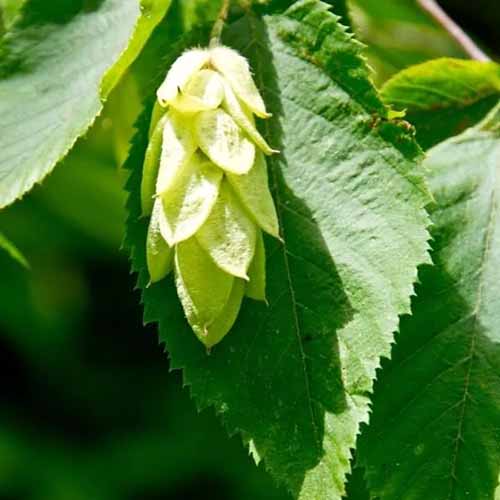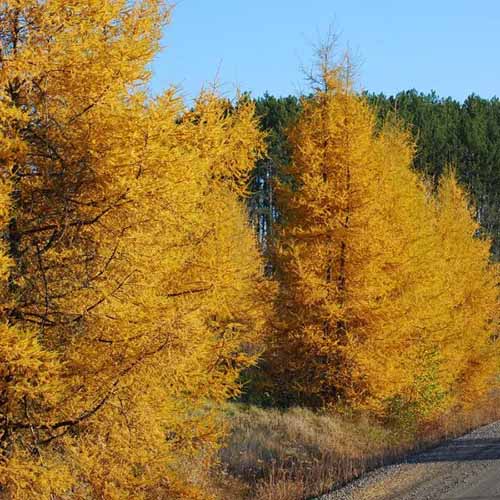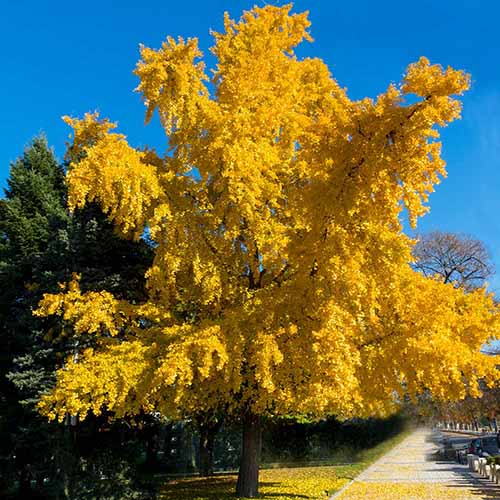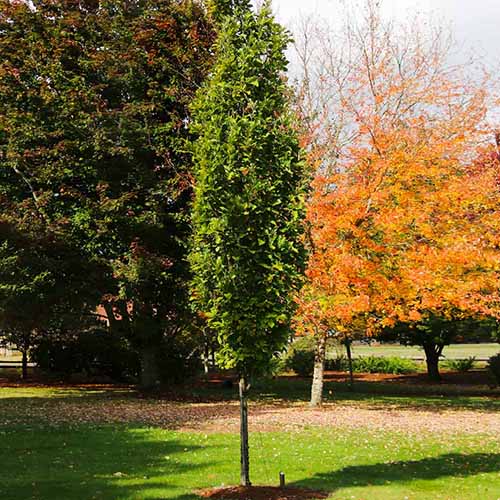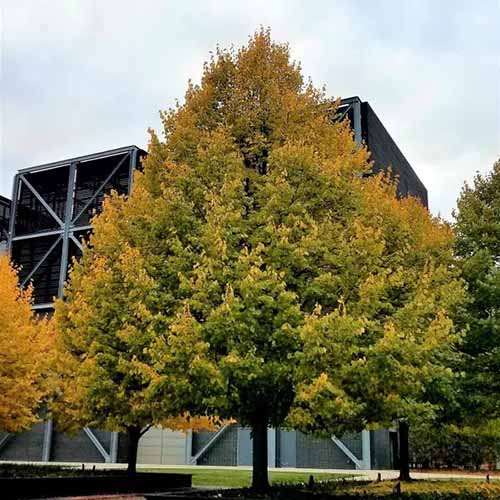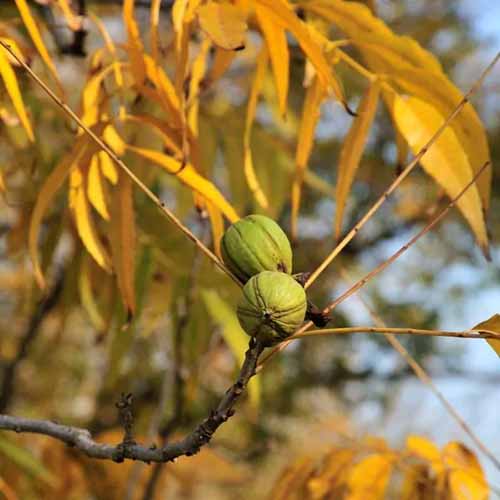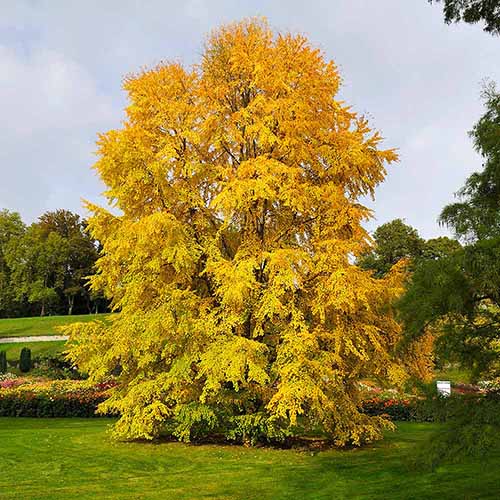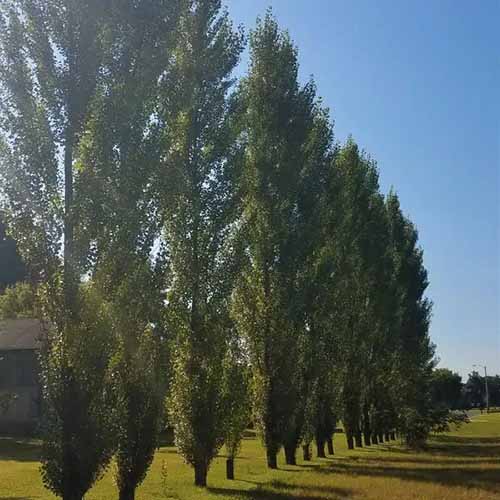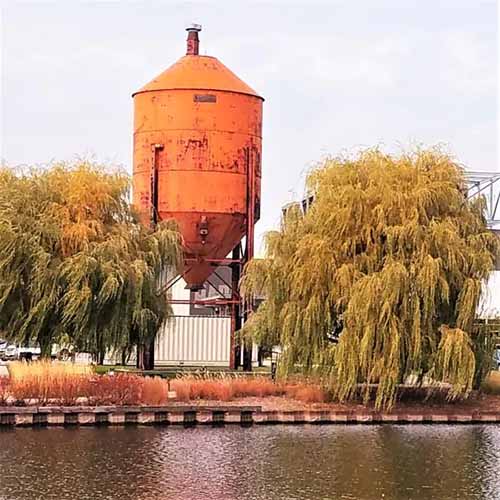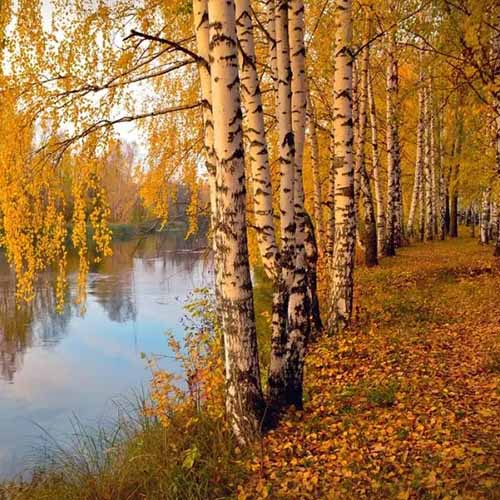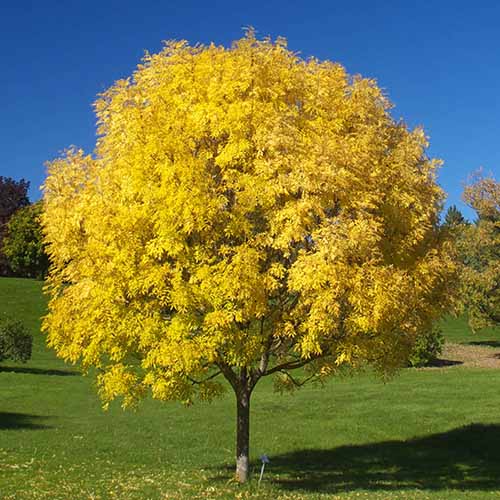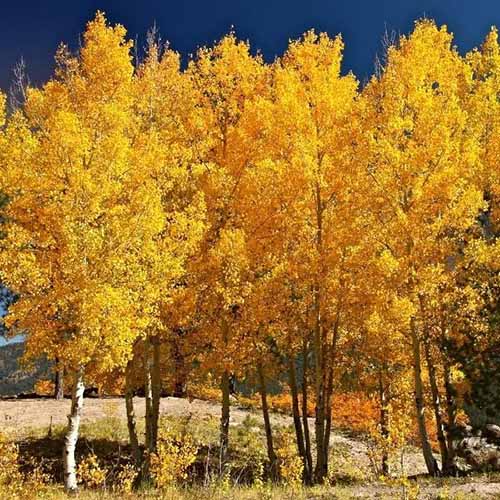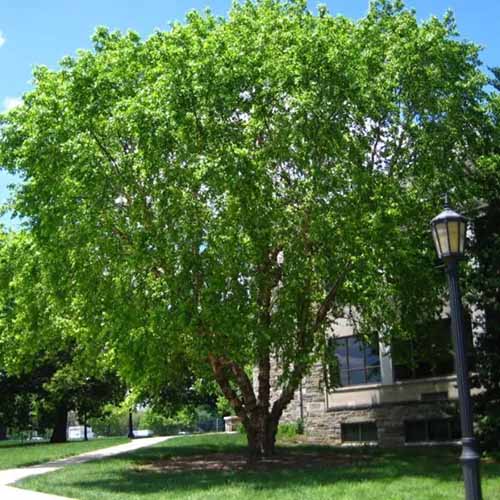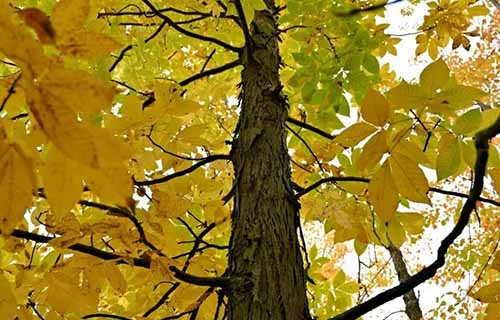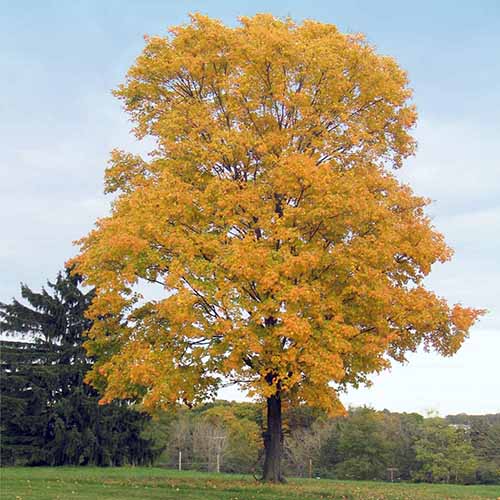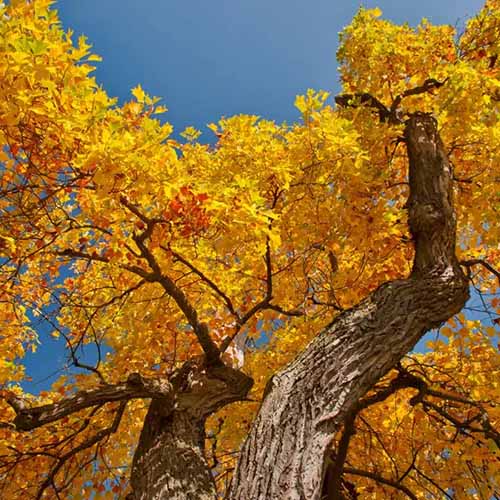For many gardeners, the arrival of fall is a reward for a job well done.
The spring and summer sowing, tending, watering, and weeding that produced abundant flowers and food for the table are a memory.
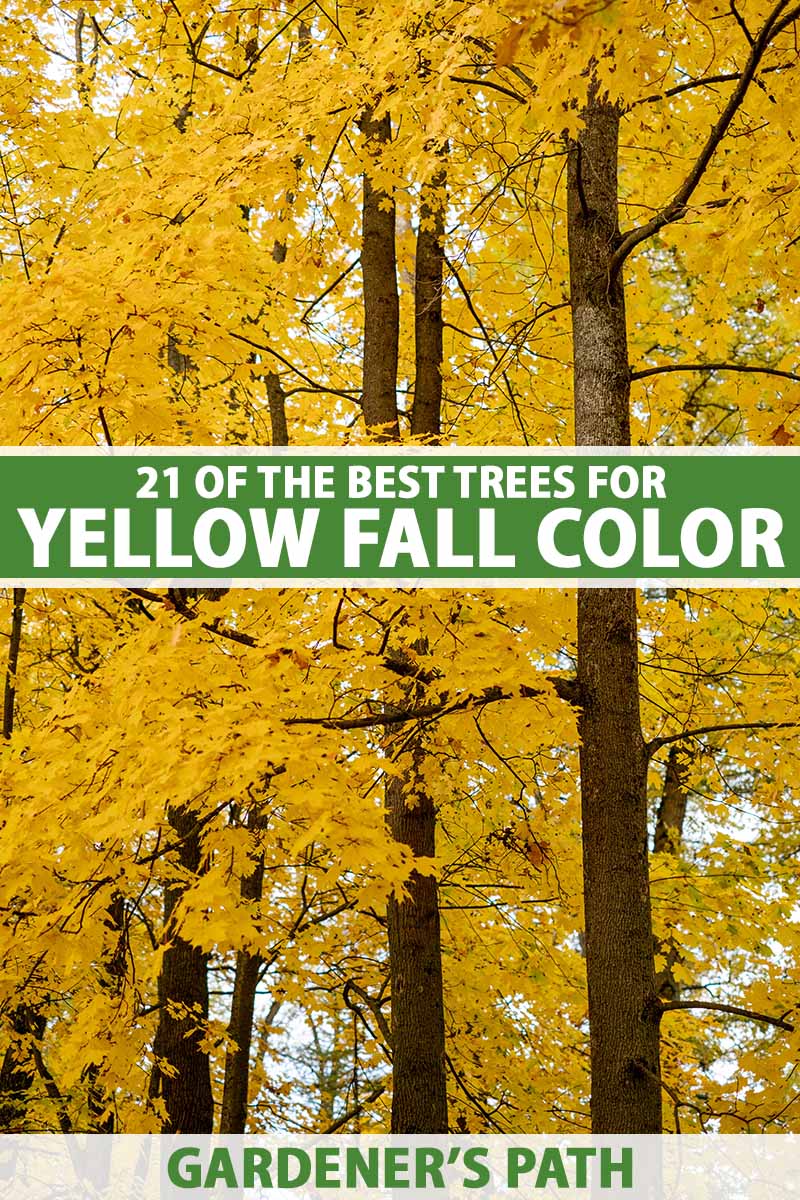
We link to vendors to help you find relevant products. If you buy from one of our links, we may earn a commission.
Cooler days and reports of peak “leaf-peeping” opportunities prompt mass exoduses to wooded locales to enjoy the changing of the foliage.
If you have the space to plant new landscape trees, this article’s for you.
In addition to evaluating their shade, nuts, fruits, flowers, and dimensions, consider the colors the leaves turn in the fall.
Our guides to landscape tree cultivation discuss planting and caring for various species and cultivars.
This article offers a roundup of 21 trees that are outstanding for their yellow fall foliage.
Here’s our lineup:
21 of the Best Trees for Yellow Fall Color
Let’s get started!
1. American Hop Hornbeam
Native American hop hornbeams, Ostrya virginiana, grow well in USDA Hardiness Zones 3 to 9.
They have a symmetrical rounded to oval shape and grow to mature dimensions of 30 to 40 feet tall and 20 to 30 feet wide.
O. virginiana prefers full sun and organically-rich soil, although will tolerate some shade and sand or clay.
The foliage is lance-shaped and deeply serrated. In the fall, the leaves are a soft yellow accented by clusters of male flowers called “catkins” and dry female flowers that have run to seed and resemble hops.
Each papery capsule contains a “nutkin,” and these attract a host of foraging songbirds.
Hop hornbeams are pest and disease resistant. They have sturdy wood and a high tolerance for drought and pollutants, making them well-suited to placements as a windbreak or along roadways.
Audubon® Native American hop hornbeams are available from Nature Hills.
2. American Larch
Cold-loving American larches, aka tamaracks, Larix laricina, are suited to Zones 2 to 5.
They are deciduous conifers that blaze with golden hues before dropping their needles with the onset of winter.
Mature dimensions are a majestic 40 to 80 feet tall with a spread of 15 to 30 feet. They prefer full sun and tolerate a variety of soils and moisture levels.
Group them in boggy wetlands for an expanse of rich color.
American larches are available from Nature Hills Nursery.
Please see our guide to growing larches for more information.
3. American Pawpaw
Native American pawpaws, Asimina triloba, grow in Zones 5 to 9. Mature dimensions are 15 to 30 feet tall and wide. They prefer full sun to partial shade and moist, well-draining soil.
The overall shape is palm-like, with a tall trunk and umbrella-like canopy.
Mature trees produce brownish, malodorous flowers followed by oblong, fleshy, yellow-green fruits that many enjoy when consumed in moderation.
Pawpaws have club-shaped leaves that turn bright yellow at season’s end.
American pawpaws are available from FastGrowingTrees.com.
Pawpaws are suited to naturalistic settings, like meadows and sun-dappled woodland clearings.
See our guide to growing pawpaws for more information.
4. Autumn Gold Ginkgo
Ginkgo biloba ‘Autumn Gold’ is suited to Zones 4 to 8.
These trees have a free-form shape, exceptional horizontal branching, heights of 40 to 50 feet, and a spread of 25 to 30 feet. Full sun is preferable, and they will tolerate various soil types.
Ginkgo leaves are fan-shaped, and the autumn color of this variety is a sizzling gold. A key feature is that this cultivar is male and produces no malodorous, messy ginkgo fruits.
With their high tolerance for pollution and drought, ginkgos are a logical choice for perimeter plantings along busy streets.
‘Autumn Gold’ ginkgos are available from FastGrowingTrees.com.
Please see our guides to growing ginkgos for more information.
5. Beacon Swamp White Oak
Beacon® swamp white oaks, Quercus bicolor ‘Bonnie and Mike,’ grow in Zones 4 to 8.
Mature heights are 30 to 35 feet with a spread of 12 to 16 feet.
They are unique for having the strength of other oaks, but with upright branches for a narrow, columnar shape and smaller landscape footprint.
These trees prefer full sun locations and they’ll tolerate wetness but not alkalinity. They make excellent accents or windbreaks. Note that, like all oaks, they produce acorns.
The leaves are glossy and club-shaped with shallow lobes and a rich bronze-yellow fall color.
Beacon® swamp white oaks are available from FastGrowingTrees.com.
Please see our guide to growing oaks for more information.
6. Greenspire Linden
Greenspire™ lindens, Tilia cordata ‘PNI 6025,’ grow in Zones 4 to 7.
Their straight trunks, uniform branching, and pyramid shape make a striking statement in the landscape at heights of 40 to 50 feet with a spread of 30 to 35 feet.
Full sun is best, and these trees will tolerate various soils.
Yellow, early-summer blossoms with a spicy scent are a source of nectar for honeybees.
Linden foliage is heart-shaped and turns dazzling gold-yellow in the fall.
Excellent urban trees, lindens tolerate pollution well.
Note that it is never advisable to plant a tree below power lines, especially lindens – the trunk in mature specimens is bare for the first six feet, leaving little canopy after a utility company pruning.
Greenspire™ lindens are available from Nature Hills.
Read our our linden growing guide for more care tips.
7. Hardy Pecan
Native hardy pecan trees, Carya illinoinensis, grow in Zones 5 to 9, reaching heights of 70 to 90 feet and widths of 45 to 70 feet.
These shade trees prefer full sun and tolerate a variety of soil types. They are suited to large properties with room for the branches to spread wide.
The foliage consists of pinnate leaflets or narrow leaves along a central stem that burst into shades of harvest gold late in the season.
Support optimal pollination by planting a second type of pecan nearby. Expect your first nut harvest in seven to 15 years.
Hardy pecans are available from Nature Hills.
See our pecan growing guide for more information.
8. Hardy Red Pomegranate
Cold-hardy red pomegranates, Punica granatum, are small trees with an oval-shaped habit, suited to Zones 7 to 11.
They have mature dimensions of eight to 10 feet tall and wide. With winter protection, they will fruit in backyards even in Zone 6.
You may also be able to enjoy them in Zones 3 to 5 if you pot them and bring them indoors for the winter.
Remarkable for their cold hardiness, these trees prefer moist, loamy soil, but thrive in any soil type, provided it drains well. They are pest and disease resistant, drought tolerant, and boast minimal fruit splitting.
Spring flowers are orange-red. The branches are thorny, and the foliage is oblong to oval, lustrous, and golden yellow in the fall. Expect fruiting in two to three years.
Cold-hardy red pomegranates are available from FastGrowingTrees.com.
Please see our guide to growing pomegranates for more information.
9. Harvest Gold Crabapple
Harvest Gold® crabapples, aka Malus x ‘Hargozam,’ grow in Zones 4 to 8 and reach a height of 20 to 25 feet with a spread of about 15 to 25 feet.
The overall shape is symmetrical and rounded, for a focal specimen planting.

The leaves are elliptical and serrated. Showy white spring flowers precede yellow, round, berry-like fruits that persist into winter, complementing the yellow autumn foliage.
Foraging birds feast on the fruits, so you don’t have to clean them up.
These trees prefer full sun and well-draining soil. They tolerate clay and occasional wetness and are disease and pest resistant.
Harvest Gold® crabapples are available from Online Orchards via Home Depot.
Disregard the mention of red leaves in the short product summary. This variety produces yellow fall foliage, as indicated in the longer description on the Home Depot website.
Please see our crabapple growing guide for more information.
10. Katsura
Katsuras, Cercidiphyllum japonicum, grow in Zones 4 to 8. Mature dimensions are 40 to 60 feet tall with a spread of 25 to 60 feet, and they may have one or more main trunks.
These trees prefer full sun to partial shade and require well-draining soil. In the early years, they do best with consistent moisture.
The foliage is almost round with a slight teardrop shape and stunning yellow in the fall.
These trees tolerate pollution and are noteworthy for having a shallow root system that does not disturb underground pipes or cause sidewalk buckling.
Katsuras are available from FastGrowingTrees.com.
11. Lombardy Poplar
Lombardy poplars, Populus nigra ‘Italica,’ are suited to Zones 3 to 9. They have a columnar shape that makes an excellent privacy screen when multiple specimens are planted in a row.
Mature dimensions are 40 to 60 feet tall with a spread of 10 to 15 feet. These hardy poplars prefer full sun, grow well in various soils, and are drought tolerant.
The triangular leaves rustle pleasantly when a breeze passes through them. In autumn, they blaze yellow like summer sunshine.
Lombardy poplars are available from Nature Hills Nursery.
12. Niobe Weeping Willow
Niobe or golden weeping willows, Salix alba ‘Tristis,’ grow in Zones 4 to 8, reaching heights of 50 to 60 feet with a spread of 30 to 40 feet. They prefer full sun and moist soil of any variety.
Weeping willows have finely serrated narrow leaves with golden autumn hues and light, airy branches that cascade gracefully downward, often sweeping the ground with passing breezes.
It’s best to plant away from underground sewer pipes, as willow roots grow invasively and may clog them.
Niobe weeping willows are available from Nature Hills.
Please see our weeping willow growing guide for more information.
13. Paper Birch
Native paper birches, Betula papyrifera, grow in Zones 2 to 7.
Their statuesque trunks have highly ornamental white, peeling bark and a loosely pyramidal shape, making them attractive stand-alone or clumped focal points.
Heights reach 40 feet with a spread of 30 feet.
They prefer full sun to partial shade and grow in most soil types. They require moderate moisture and do not tolerate drought.
The teardrop-shaped leaves are serrated and bright yellow in the fall.
Paper birches are available from Nature Hills.
14. Patmore Green Ash
‘Patmore’ green ashes, Fraxinus pennsylvanica ‘Patmore,’ are suited to Zones 3 to 9.
They have a rounded, lollipop shape that makes them eye-catching stand-alone specimens. Mature heights are 50 to 70 feet with a spread of 35 to 40 feet.
Pest and disease resistant, they prefer full sun and moist soil but tolerate various soil types and some drought.
Note that if you live in a region where the emerald ash borer beetle is prevalent, you may wish to avoid new plantings, or follow a preventative integrated pest management program.
Fast-growing, green ashes put on approximately two feet per year through to maturity. The foliage consists of shiny, lance-shaped leaflets that turn a bright, sunny yellow hue in the fall.
Ashes generally produce “samaras,” narrow, tan, papery seed pods. But with the ‘Patmore’ cultivar, you’ll have no messy seeds to rake up.
‘Patmore’ green ashes are available from FastGrowingTrees.com.
15. Princeton Elm
‘Princeton’ elms, Ulmus americana ‘Princeton,’ grow in Zones 4 to 9. Mature dimensions are 60 to 80 feet tall and 40 to 60 feet wide, making them excellent stand-alone specimen shade trees.
The overall shape is like a vase, with dense, upwardly arching branches. The foliage is elliptical and serrated, and flushes yellow at season’s end.
Unlike many elms, ‘Princeton’ is highly resistant to Dutch elm disease. These prefer full sun placements and adapt to most soils.
‘Princeton’ elms are available from Nature Hills.
Please see our guide to growing elms for more information.
16. Quaking Aspen
Native quaking aspens, Populus tremuloides, grow in Zones 2 to 6, where they rise to heights of 40 to 50 feet with a spread of 20 to 30 feet.
They thrive in full sun in a range of soils and add the calming sound of gently rustling leaves to the landscapes they adorn.
Tall trunks and a pyramid shape show the crisp, white bark to the best advantage, especially in an impressive stand of multiple trees in a row.
The foliage is near heart-shaped with serrated margins. The leaves are golden in the fall and sometimes surprise with red tones.
Quaking aspens are available from Nature Hills Nursery.
17. River Birch
River birches, Betula nigra, are stunning in Zones 3 to 9.
In addition to their brief but glorious fall display of buttery, serrated, diamond-shaped leaves and dangling reddish-green catkins, they sport cinnamon-brown exfoliating bark.
Mature heights are 25 to 50 feet tall and 25 to 35 feet wide. As they age, they transition from a pyramid to a rounded shape.
These trees prefer full sun to part shade and tolerate drought, various soils, and wind.
Plant them in naturalized areas and clump to create privacy. Avoid planting near buildings, as branches will likely fall into rain gutters.
River birches are available from Nature Hills.
18. Shagbark Hickory
Shagbark hickories, Carya ovata, are suited to Zones 4 to 8. They are large shade trees with a rounded crown and an irregular shape that mature to 70 to 90 feet tall and 50 to 70 feet wide.
The foliage is lance shaped, slightly serrated, and golden yellow in the fall.
Mature specimens produce round nuts, have gray, exfoliating bark, and make impressive stand-alone trees in expansive settings.
They prefer full sun to part shade and organically-rich, well-draining soil. They tolerate clay and black walnut juglone toxicity and are not prone to pests or diseases.
Shagbark hickories are available from Walmart.
Check out our guide to growing hickories for more information.
19. Silver Maple
Vase-shaped silver maples, Acer saccharinum, grow in Zones 3 to 9.
They reach heights of 50 to 80 feet with a spread of 35 to 70 feet, adding approximately three feet per year to their landscape footprint until they reach maturity.
These trees prefer full sun to part shade and medium to wet soil. However, they tolerate drought well.
They have deeply lobed leaves that are characteristic of maple trees. Winged seed pods called “samaras” disperse in the spring. The fall color is pale lemon yellow.
The best placements are moist areas like streambeds and riverbanks away from buildings and cars, as silver maple limbs are susceptible to breakage in high winds and ice storms.
Silver maples are available from FastGrowingTrees.com.
Read more about growing maples in our guide.
20. Thornless Honey Locust
Fast-growing, native, thornless honey locusts, Gleditsia triacanthos var. inermis, are suited to Zones 4 to 9.
They reach 50 to 70 feet tall with a spread of 40 to 50 feet, adding approximately two feet per year until maturity, and lack the long thorns found on the branches of the thorned variety.
These trees prefer full sun to part shade and moist, loamy soil. They will also tolerate other soils, dryness, wetness, and road salt.
The overall shape is upward arching and oval, with foliage consisting of pinnate leaflets with narrow, oblong foliage.
Spring brings fragrant, nondescript blossoms and long, reddish-brown seed pods. In the fall, the leaves are golden.
Honey locusts make a bold statement and provide ample shade in large yards.
Thornless honey locusts are available from Nature Hills.
21. Tulip Poplar
Native tulip poplars Liriodendron tulipifera, grow in Zones 4 to 9. Mature dimensions are 60 to 90 feet tall and 30 to 50 feet wide. They require full sun with loose, loamy, well-draining soil.
Also called tulip trees, they are in the magnolia family and are unrelated to tulips or poplars.
They have tulip-like flowers that bloom high in the canopy in the spring in shades of orange, yellow, and green.
Tulip poplars show well in wooded, naturalistic settings where they are somewhat sheltered from potentially damaging winds.
These trees have a pyramid shape when young and mature to an oval form. The palmate or hand-like leaves also resemble tulips. Fall foliage is golden.
Tulip poplars are available from Nature Hills.
The Backbone of a Vibrant Fall Display
With 21 landscape trees that offer exciting yellow hues, it’s time to pick your favorites and add them to your garden planner.
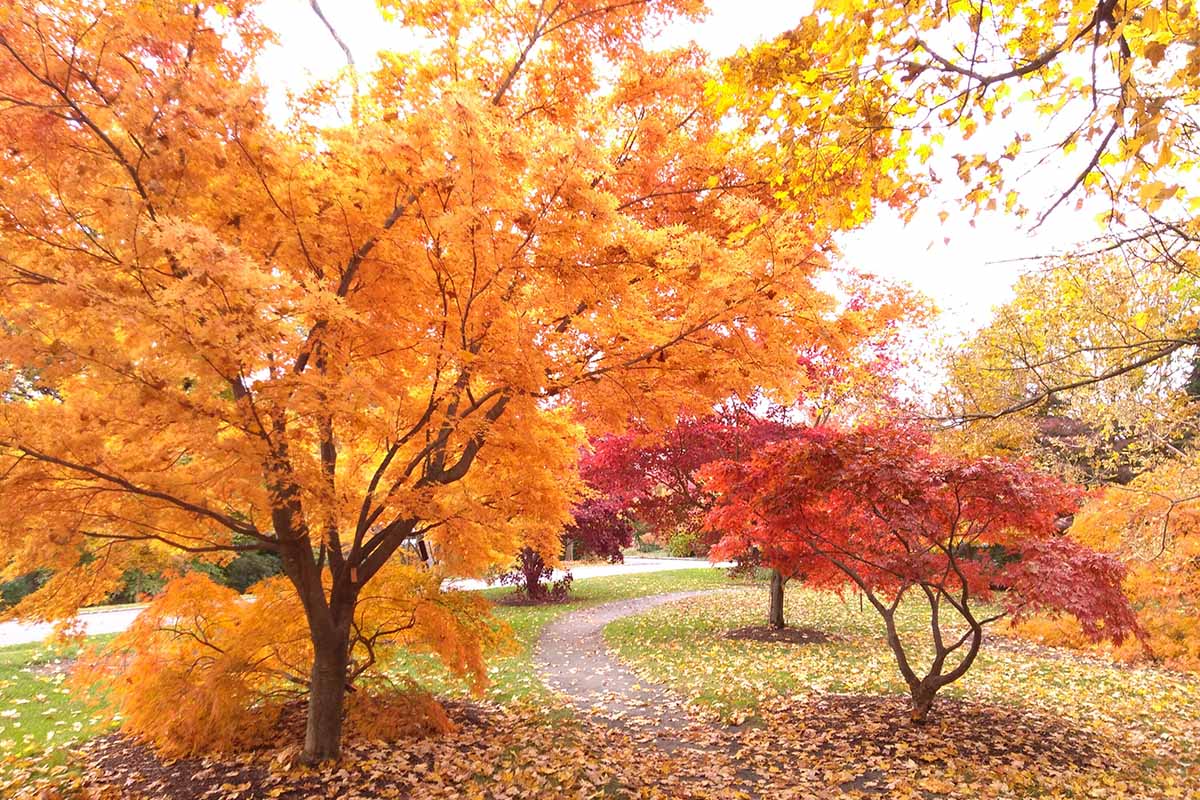
When cool, crisp days arrive, you’ll be glad you chose landscape trees with yellow fall foliage. Yellow hues are the backbone of a late-season display punctuated by oranges, russets, and scarlets.
What yellow-leafed trees grow in your outdoor living space? Tell us about them in the comments section below.
If you enjoyed this round-up of trees with yellow fall foliage, we recommend the following guides next:
